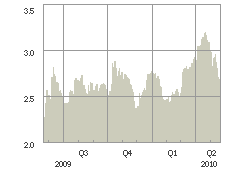The impact of the European Union’s credit crunch in their less than financially solvent countries is playing out before our eyes. Since the market has had the ability to see this event happening far in advance, I do not believe the impact will be nearly as severe as the US credit crunch. In addition, the US/Canadian direct exposure to Greek debt is limited, but indirect exposure (via the European banks, who have the real exposure) may be significant.
The obvious impact, now that this has clearly hit the media, is the following:
1. Whenever there is a financial crisis, the rush to safety always goes into US dollars and US treasury bonds. 30-year yields are down from 4.8% to 4.4% in April. Canadian bonds have seen some inflow, but not nearly as much as the USA.
2. US currency, relative to the Euro is signifciantly higher, but this has been being priced into the market over the past few months. The Canadian dollar has been relatively unchanged against the US currency.
3. Stocks will take their tumbles as people rush for liquidity and reduce risk.
4. Commodities will be lower due to less implied demand.
The EU bailout will, at most, be a band-aid for the Greek government, but does not address the underlying problem in any way, mainly that the list of entitlements that the Greek government has promised its people it cannot pay for. This should be a word of caution for those that think the government can continue to have most of its people on the dole without consequence – if there is no political will to reform entitlement programs, then the financial market will make the decision for you. In the case of Greece, it has clearly come to this point.
Greece, by joining the Euro, has removed one important tool that could have otherwise allowed it to recover – currency devaluation. Without a devaluation option, they have to make politically much more difficult choices.
In the grand scheme, Canada is relatively placed better than most European countries, as long as we don’t keep giving out entitlements thinking they are free.
In terms of future decisions, it would imply that interest rates would be kept lower with an expanded European crisis than without, so this could be a boost to fixed income securities.
I don’t think this will transform into a market meltdown like what happened in 2008, although again, I could be wrong. If the markets do continue to plunge, this is exactly what you have cash reserves for – to snap up underpriced bargains that have gotten to that price level because of other people forced to liquidate.
